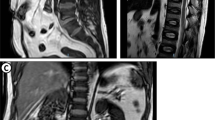Abstract
Light chain (AL) amyloidosis is the result of a clonal plasma cell disorder which causes organ damage by deposition of misfolded light chains. Kidney is a common site of amyloid deposition. Proteinuria, usually in nephrotic range and unexplained renal insufficiency are the main manifestations of renal injury. We report a unique case of renal involvement by AL amyloidosis masquerading as metabolic bone disease. 38 year old male patient presented with progressively increasing diffuse bony pains, low backache and proximal weakness of both lower limbs since two years. On investigation, he was detected to have hypophosphatemic osteomalacia due to renal phosphate loss which was fibroblast growth factor 23 (FGF23)- independent. He also had nephrotic range low molecular weight proteinuria. Renal biopsy to ascertain the aetiology revealed deposition of amyloid fibrils in the glomerular mesangium on electron microscopy. Its characterization by immunofluorescence (IF) was consistent with immunoglobulin light chain (AL) amyloidosis. In the absence of a demonstrable plasma cell clone on bone marrow biopsy, we made a diagnosis of monoclonal gammopathy of renal significance (MGRS). He was treated with chemotherapy following which there was symptomatic improvement and reduction in phosphaturia. This case describes a unique presentation of renal injury due to AL amyloidosis masquerading as hypophosphatemic osteomalacia. The aim of this report is to highlight that hypophosphatemia in adults is usually acquired and treatment of underlying etiology results in cure, unlike in children where genetic counseling and phosphate replacement is the mainstay of treatment.

Similar content being viewed by others
References
Sheih A (2017) An introduction to bone disorders. Endocrinol Metab Clin N Am 46(1)
Leung N, Bridoux F, Batuman V et al (2019) The evaluation of monoclonal gammopathy of renal significance: a consensus report of the International Kidney and Monoclonal Gammopathy Research Group. Nat Rev Nephrol 15(1):45–59
Kyle RA, Gertz MA (1995) Primary systemic amyloidosis: clinical and laboratory features in 474 cases. Semin Hematol 32:45–59
Palladini G, Russo P, Bosoni T et al (2009) Identification of amyloidogenic light chains requires the combination of serum-free light chain assay with immunofixation of serum and urine. Clin Chem 55(3):499
Novak L, Cook WJ, Herrera GA, Sanders PW (2004) AL-amyloidosis is underdiagnosed in renal biopsies. Nephrol Dial Transplant 19(12):3050–3053
Wechalekar AD, Hawkins PN, Gillmore JD (2008) Perspectives in the treatment of AL amyloidosis. Br J Haematol 140(4):365–377
Carone FA, Epstein FH (1960) Nephrogenic diabetes insipidus caused by amyloid disease. Evidence in man of the role of the collecting ducts in concentrating urine. Am J Med 29:539–544
Rikitake O, Sakemi T, Yoshikawa Y, Nagano Y, Watanabe T (1989) Adult Fanconi syndrome in primary amyloidosis with lambda light-chain proteinuria. Jpn J Med 28(4):523–526
Ciocchini M, Arbelbide J, Musso CG (2017) Monoclonal gammopathy of renal significance (MGRS): the characteristics and significance of a new meta-entity. Int Urol Nephrol 49(12):2171–2175
Stokes MB, Valeri AM, Herlitz L et al (2015) Light chain proximal tubulopathy: clinical and pathologic characteristics in the modern treatment era. J Am Soc Nephrol 27:1555–1565
Herrera GA (2014) Proximal tubulopathies associated with monoclonal light chains: the spectrum of clinicopathologic manifestations and molecular pathogenesis. Arch Pathol Lab Med 138:1365–1380
Vignon M, Javaugue V, Alexander MP, el-Karoui K, Karras A, Roos-Weil D, Royer B, Asli B, Knebelmann B, Touchard G, Jaccard A, Arnulf B, Bridoux F, Leung N, Fermand JP (2017) Current anti-myeloma therapies in renal manifestations of monoclonal light chain-associated Fanconi syndrome: a retrospective series of 49 patients. Leukemia 31(1):123–129
Gertz MA, Leung N, Lacy MQ, Dispenzieri A, Zeldenrust SR, Hayman SR, Buadi FK, Dingli D, Greipp PR, Kumar SK, Lust JA, Rajkumar SV, Russell SJ, Witzig TE (2009) Clinical outcome of immunoglobulin light chain amyloidosis affecting the kidney. Nephrol Dial Transplant 24:3132–3137
Fernández de Larrea C, Verga L, Morbini P, Klersy C, Lavatelli F, Foli A, Obici L, Milani P, Capello GL, Paulli M, Palladini G, Merlini G (2015) A practical approach to the diagnosis of systemic amyloidosis. Blood 125(14):2239–2244
Schönland SO, Hegenbart U, Bochtler T et al (2012) Immunohistochemistry in the classification of systemic forms of amyloidosis: a systematic investigation of 117 patients. Blood 119(2):488–493
Dember LM (2006) Amyloidosis associated kidney disease. J Am Soc Nephrol 17:3458–3471
Fermand JP, Bridoux F, Dispenzieri A, Jaccard A, Kyle RA, Leung N, Merlini G (2018) Monoclonal gammopathy of clinical significance: a novel concept with therapeutic implications. Blood 132(14):1478–1485
Rysavá R (2019) AL amyloidosis: advances in diagnostics and treatment. Nephrol Dial Transplant 34:1460–1466
Author information
Authors and Affiliations
Corresponding author
Ethics declarations
Conflict of interest
None. We confirm that this work is original and has not been published elsewhere nor is it currently under consideration for publication elsewhere. The data has not been presented earlier as a poster or abstract.
Additional information
Publisher’s note
Springer Nature remains neutral with regard to jurisdictional claims in published maps and institutional affiliations.
Rights and permissions
About this article
Cite this article
Malhotra, R., Guleria, P., Barwad, A. et al. A unique case of light chain (AL) amyloidosis masquerading as hypophosphatemic osteomalacia. Osteoporos Int 32, 387–392 (2021). https://doi.org/10.1007/s00198-020-05622-7
Received:
Accepted:
Published:
Issue Date:
DOI: https://doi.org/10.1007/s00198-020-05622-7




